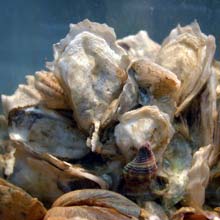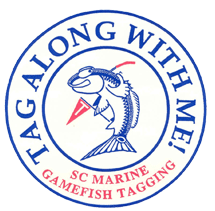Marine - Species
SC Species Regulations for Eastern oyster
Saltwater Fishing License required.
Season: Typically open October 1 through May 15 (½ hour before sunrise to ½ hour after sunset). Call 843-953-9300 for season dates.
Eastern oyster (Crassostrea virginica)
General Description
Drab, scaly or encrusted; shape variable; shell ranges from thin, elongated, and highly irregular (intertidal) to heavy and regular (subtidal); left valve typically thicker and concave, right valve relatively flat; posterior adductor muscle scar purple.
Average Size
Market size 4 – 6 inches; at approx. 3 – 5 years of age; can reach harvestable size after 2 – 3 years.
Habitat
Estuaries, salt marsh, mudflats, tidal bays and sounds; typically form intertidal reefs extending from just below mean low water to approximately 3 feet higher. Once settled, sessile throughout life.
Reproductive Cycle
- Mature within months of setting and reproduce by the end of first year. Protandrous hermaphrodites, beginning life as male and switching to female later in life.
- Spawn intermittently May – November when water reaches at least 68°F.
- Fertilization external, producing planktonic larvae. After approx. 2 – 3 weeks larvae metamorphose and “set” on hard substrates to become "spat"; oyster shells/reef preferred substrate. Peak recruitment June – September.
Foraging Habits
- Filter particles from seawater, including phytoplankton, diatoms, dinoflagellates, and detritus. Particles bound in mucus and passed to small palps to be consumed or expelled.
Availability/Vulnerability to Harvest
- Predominantly intertidal in South Carolina to avoid subtidal predators such as oyster drills. Highly tolerant of temperature and salinity fluctuations where currents deliver suspended food particles without increasing turbidity.
- Oyster reefs provide habitat and support food webs that promote the survival of many recreationally and commercially important species (sheepshead, black drum, red drum, spotted seatrout, flounder, croaker, spot, penaeid shrimp, blue crab) and support anemones, sponges, hydrozoans, crabs, mussels, worms, gobies, blennies.
- Conservation concerns: past uncontrolled harvesting and lack of shell replacement for settling of larvae; degradation and loss of estuarine habitat; compromised water quality (increased runoff, pollution, sedimentation); mortality due to water quality and disease.
Literature Cited
Bahr LM, WP Lanier. 1981. The ecology of intertidal oyster reefs of the South Atlantic coast: A community profile. U.S. Fish and Wildlife Service, Office of Biological Services, Washington D.C. FWS/OBS-81/15. 105 pp.
Burrell Jr. VG. 1986. Species profiles: life histories and environmental requirements of coastal fishes and invertebrates (South Atlantic) – American oyster. U.S. Fish Wildl. Serv. Biol. Rep. 82(11.57). U.S. Army Corps of Engineers TR EL-82-4. 17 pp. Accessed: January, 2010.
Burrell Jr. VG. 2003. South Carolina oyster industry: a history. VG Burrell Publ., Charleston, SC. 67 pp.
Coen LD, MW Luckenbach, DL Breitburg. 1999. The role of oyster reefs as essential fish habitat: a review of current knowledge and some new perspectives. Amer Fish Soc Symposium 22: 438-454.
Eastern Oyster Biological Review Team. 2007. Status review of the eastern oyster (Crassostrea virginica). Report to the National Marine Fisheries Service, Northeast Regional Office. February 16, 2007. NOAA Tech. Memo. NMFS F/SPO-88, 105 pp. Available: https://spo.nmfs.noaa.gov/sites/default/files/TMSPO88.pdf. Accessed: January, 2010.
Keith WJ, RC Gracy. 1972. History of the South Carolina oyster. Educational Report no. 1. SC Wildlife and Marine Resources Department, Charleston, SC. 19 pp.
Kennedy VS, RIE Newell, AF Eble (Eds.). 1996. The eastern oyster: Crassostrea virginica. Maryland Sea Grant College, College Park, MD. 734 pp.
Smith D, M Monti. 1996. Oyster biology. Virginia Marine Resource Bulletin 28: 8-9.


